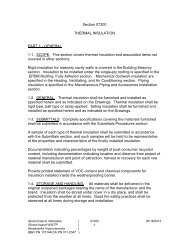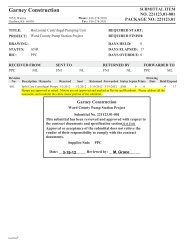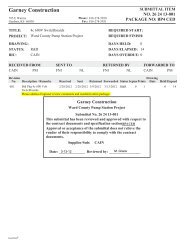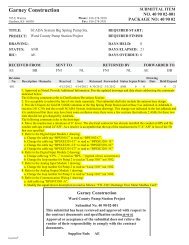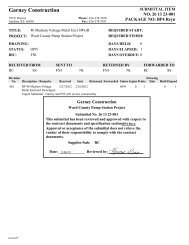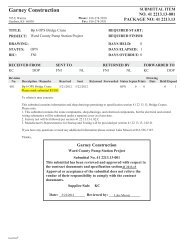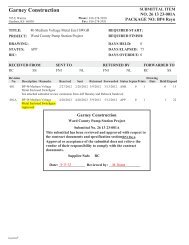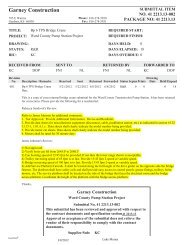33 12 16.26 - 001-A - Butterfly Valves - Garney Construction
33 12 16.26 - 001-A - Butterfly Valves - Garney Construction
33 12 16.26 - 001-A - Butterfly Valves - Garney Construction
You also want an ePaper? Increase the reach of your titles
YUMPU automatically turns print PDFs into web optimized ePapers that Google loves.
6<br />
Cable Connections<br />
14<br />
WARNING:<br />
Ensure all power supplies are<br />
isolated before removing<br />
actuator covers.<br />
Check that the supply voltage agrees<br />
with that stamped on actuator<br />
nameplate.<br />
A switch or circuit breaker must be<br />
included in the wiring installation of the<br />
actuator. The switch or circuit breaker<br />
shall be mounted as close to the<br />
actuator as possible and shall be<br />
marked to indicate that it is the<br />
disconnecting device for that particular<br />
actuator. The actuator must be<br />
protected with overcurrent protection<br />
devices rated in accordance with Rotork<br />
publication No. E130E Electric motor<br />
performance data for IQ range<br />
actuators.<br />
WARNING:<br />
Actuators for use on phase to<br />
phase voltages greater than 600V<br />
a.c.must not be used on supply<br />
systems such as floating, or<br />
earth-phase systems, where<br />
phase to earth voltages in excess<br />
of 600V a.c. could exist.<br />
6.1 Earth/Ground Connections<br />
A lug with a 6mm diameter hole is cast<br />
adjacent to the conduit entries for<br />
attachment of an external protective<br />
earthing strap by a nut and bolt. An<br />
internal earth terminal is also provided,<br />
however it must not be used alone as<br />
the protective Earth Connection.<br />
6.2 Removing Terminal Cover<br />
Using a 6mm Allen key loosen the four<br />
captive screws evenly. Do not attempt<br />
to lever off the cover with a screwdriver<br />
as this will damage the “O” ring seal<br />
and may damage the flamepath on a<br />
certified unit.<br />
Fig. 6<br />
Actuators containing a Setting Tool<br />
fitted to the inside of the terminal<br />
compartment cover are identified with<br />
a self-adhesive yellow label on the<br />
outside of the terminal compartment<br />
cover.<br />
The wiring code card fixed in the cover<br />
is particular to each actuator and must<br />
not be interchanged with any other<br />
actuator. If in doubt check the serial<br />
number on the code card with that of<br />
the actuator.<br />
Fig. 6.1<br />
A plastic bag in the terminal<br />
compartment contains:<br />
Terminal screws and washers.<br />
Spare cover “O” ring seal.<br />
Wiring diagram.<br />
Instruction book.<br />
Fig. 6.2<br />
6.3 Cable Entry<br />
Only appropriate certified Explosion-<br />
Proof entry reducers, glands or conduit<br />
may be used in hazardous locations.<br />
Remove red plastic transit plugs. Make<br />
cable entries appropriate to the cable<br />
type and size. Ensure that threaded<br />
adaptors, cable glands or conduit are<br />
tight and fully waterproof. Seal unused<br />
cable entries with a steel or brass<br />
threaded plug. In hazardous areas an<br />
appropriately certified threaded<br />
blanking plug must be used.





